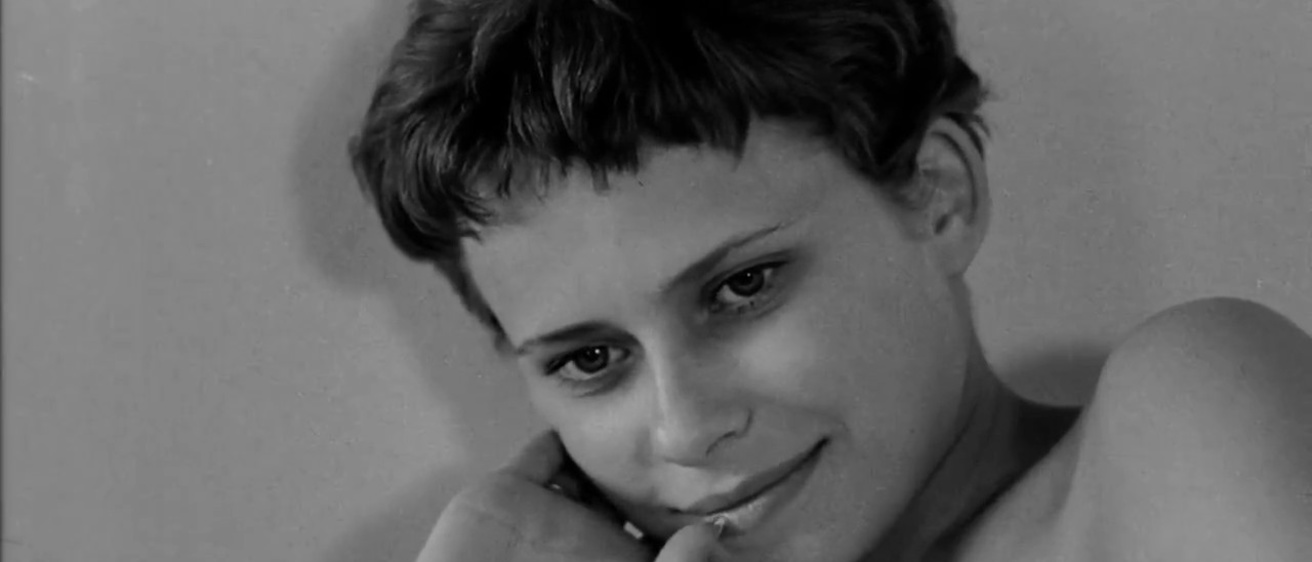Te (You) (1963) is a short film by István Szabó (best known for his 1981 film, Mephisto). For all 10 minutes of its runtime, the film focuses solely on the director’s then-girlfriend: Hungarian actress Cecília Esztergályos. The short begins with a slideshow of women in paintings. We hear the voice of Cecília, who asks István to draw her, to which he replies he can’t. “To me, everything moves.” He says, “This is your essence. The way you lift, then lower your arm. Walk, stop, and start walking again.” From the beginning the thesis is clear: this film is an artist “painting” their lover onto celluloid. What follows are numerous vignettes featuring Cecília as she travels the city, each soundless and plotless, focused entirely on movement through space. We watch her in-motion as she walks, runs, lounges, smiles, twirls, tries on glasses, and fixes her hair. We’re allowed to spectate the pleasing mechanisms of the human body (see the grand finale milk-drinking sequence) free from any socio-cultural repercussion, safe from the eyes of the subject; behind our screens.
Interspersed throughout the film are segments of conversation between Cecília and István. This is the only time we hear Cecília speak. She playfully jabs at István, challenging his affections. During these segments, Cecília looks directly at István, reading his face and dissecting the responses he gives. But the camera does not point this gaze at us, it’s placed askew. We see her from the perspective of a third-party. Even when Cecília holds control, we—the spectator–are allowed to retain our hidden, voyeuristic position. Through the apparatus of cinema, even Cecília’s agency in the moment can later be turned into spectacle. The effect of the film then, is the complete objectification of its subject. Cecília is reduced from a person to a figure of desire and spectacle.
But I don’t feel comfortable ending the analysis there; it’s too simple an end-point for my contrarian brain. I think back to the paintings at the beginning of the film, objects which principally immortalize their subjects, canning their visage for later consumption. This process of immortalization is in-itself the process of objectification. We as a species have created a magnificent tool that allows us to capture an emotion, a thought, or a person, but the process of doing so requires translating those infinitely complex elements of our reality into finite and purely representational symbols. Whether it be a word on a page, a painting, or 24 pictures per-second, it can never become the reality in front of you. It’s impressive and admirable when an artist manages to use these symbols in a way that feels real, it’s the primary way we judge a piece of art, on how “authentic” the emotions, thoughts, and people feel as we see them on a screen. This metric of judgment has been the basis for how we deconstruct and analyze most art. However, I would argue that Te isn’t interested in this challenge of authentically portraying a human being. Te is comfortable objectifying its subject because it isn’t concerned with being deconstructed and analyzed. I don’t think the film-theory I’ve been applying so far accounts for the space in which I believe this film holds the most value: the process of its creation.
A scene which struck me on my rewatch is one where István’s camera “becomes” a car, racing down a street as Cecília narrowly dodges out of its path. Seeing Cecília’s grin as she skips through the crosswalk put me in mind of the actual conception of this shot. I imagined them walking around the city with a camera, seeing cars passing by, maybe witnessing a pedestrian in an authentic version of the scene, and suddenly having the idea for the shot. Then they race around the street to film the scene, laughing and smiling. I imagine that for every shot in this film, there’s many more that weren’t used. As I go frame-by-frame, looking for a screencap for this article, I get the palpable sense that I’m being punked, that the film is smugly unbothered by my spectation and analysis, it exists on its own terms, it doesn’t need my eyes to survive.
Te is uninterested in itself as an “end-product”. To dissect it along the lines of traditional film-theory is reductive because these methods of analysis have been developed with the idea that art is only worthwhile as an object of spectation. Te is not an object of spectation, it is an act of intimacy. The film is two lovers interacting through the process of creating art. It is a performance which is most impactful during scenes that were never filmed. Te is a love-letter written in invisible ink, its true self unparsable to any audience other than its creators.
